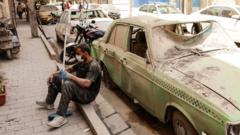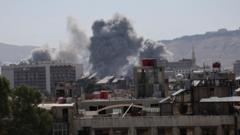Residents grapple with the aftermath of recent escalations while seeking hope for a better future.
**Tehran's Resilience Amidst Chaos: A Glimpse into Life After Conflict**

**Tehran's Resilience Amidst Chaos: A Glimpse into Life After Conflict**
In the wake of military strikes, Tehran's citizens navigate a landscape of recovery and uncertainty.
In the bustling heart of Tehran, a vibrant café called Boof has become a symbol of resilience for its residents, amidst the chaos and destruction left by Israel's military strikes. Nestled within the historical confines of the long-closed US embassy, the café serves refreshing iced Americanos and is adorned with murals, remnants of a strained relationship spanning decades. Barista Amir expresses his desire for diplomatic relations to improve, recognizing the detrimental effects of US sanctions on local businesses.
Just a short distance away, inside the complex of the state TV station IRIB, the gravity of the situation has become palpable. Following intense bombardments that have turned media facilities into charred ruins, the Supreme Leader Ayatollah Ali Khamenei addressed the nation, propelling a narrative of resistance against external aggression. The remnants of the IRIB compound tell tales of destruction, as burnt cables and crumbled walls reflect the conflict that has shaken Tehran to its core.
Medical facilities across the city, like the Taleghani General Hospital, are overwhelmed with casualties from the renewed violence. Head nurse Ashraf Barghi shares her fear and exhaustion as she tends to the injured, recounting how the strikes have left a mark on her psyche. The visibility of damage, combined with the number of casualties reported—over 600 dead and thousands injured—is a stark reminder of the human cost of conflict.
Despite the turmoil, Tehran appears to be regaining its rhythm. Streets that once witnessed quietude are now bustling with traffic once again, as shops in local bazaars reopen. Yet, many residents like Mina struggle to articulate their pain and fears for the future, expressing how the events have pushed their aspirations aside.
On a warm summer's evening, the iconic Azadi Tower serves as a backdrop for an open-air concert by the Tehran Symphony Orchestra, eliciting a mixture of nostalgia and hope among its attendees. Citizens, clad in both traditional and modern attire, gather to find solace in music, transcending political divides, and echoing a collective yearning for greater freedom and stability.
Even amidst stringent regulations, Tehranis express their opinions and hopes for a diplomatic conversation that can pave the way for a peaceful future. With Iran's political landscape under scrutiny from both domestic and international communities, the road ahead remains fraught with challenges. Nevertheless, the spirit of the city endures as its residents navigate the complexities of recovery, survival, and the hope for a brighter horizon ahead.





















